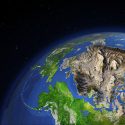The Earth might not be here forever. A huge solar flare, an asteroid impact, or a local gamma-ray burst – anything could wipe us out for good.
If we’re looking for someplace to escape to, there is one planet in our Solar System that is somewhat similar to Earth, though we don’t know much about it. It might even be hosting some microbial life. No, it’s not Mars – it’s Venus.
Not only are Earth and Venus about the same size, they both have identical interiors with partially liquid cores, mantles and crusts. Yet, Venus happens to be the most hostile terrestrial planet in the Solar System.
But what if I told you that you could explore this hot planet without ever setting foot on it? Venus isn’t a place you’d want to land on. Thanks to its dense atmosphere and turtle-like rotation, the surface temperature of Venus stays at 462°C (863.6°F).
The planet’s atmospheric pressure is 92 times greater than Earth’s. Because of such high pressure, anything entering the atmosphere of Venus gets immediately crushed before it reaches the planet’s volcanic surface.
With such extreme atmospheric conditions, it is too dangerous to attempt a manned landing on Venus. But we wouldn’t need to go down there.
Above the dense layer of clouds, Venus isn’t that bad. The atmospheric pressure is similar to Earth’s. The gravity is slightly lower. The temperature reaches 75°C (167°F). Although that’s a little hot, it’s still workable.
How would we get there? Well, we’d need to start small. According to NASA’s plan for exploring Venus, we’d send two spaceships to our destination.
Venus is the closest planet to Earth. That’s why it would only take 100 days for the craft to arrive there.
One of the ships would be run by robots. It would carry a special airship that it would eject into the atmosphere upon arrival.
This airship would start to inflate itself with helium. Since helium is lighter than air, the airship would float, orbiting about 52 km (32 mi) above the planet.
The second spaceship would have a crew of two people. It would link up with the airship orbiting Venus.
The crew would have 30 days to make all the environmental assessments. After that, they’d detach from the airship and start making their way back to Earth.
The return trip would take about 300 days due to the Sun’s strong gravitational pull. Even with that, the complete mission wouldn’t take longer than 450 days.
After analyzing the information from the first mission, we’d begin to plan our next trip to Venus. But this time, we’d stay there longer.
The next crew would have a year to study the planet and its atmosphere. One of the things they’d be looking for on Venus would be life. Scientists think that because microbes on Earth can thrive in acidic conditions surrounded by sulfur, there could be life found in the Venusian atmosphere.
After the end of the second mission, we would start preparing to stay on Venus permanently. We would begin building cloud cities, where future generations of humans would live and hopefully continue to explore space and the origins of life in it.
They might even solve the pressure problem. From there, they would terraform the planet and settle down on the once hostile Venusian surface.
Subscribe to What-If on Youtube or follow the show on Facebook Watch.
Sources
- “The Amazing Cloud Cities We Could Build On Venus”. Becker, Adam. 2019. bbc.com. Accessed August 19 2019.
- “Full Page Reload”. Ackerman, Evan, 2019. IEEE Spectrum: Technology, Engineering, And Science News. Accessed August 19 2019.
- “Venus Compared To Earth – Universe Today”. Williams, Matt, 2016. Universe Today. Accessed August 19 2019.
- “How NASA Could Build a Clout City Over Venus” Dvorsky, George, 2019. io9.gizmodo.com. Accessed August 19 2019.
- “Venus Facts: Interesting Facts About Planet Venus • The Planets”. The Planets. Accessed August 19 2019.



























